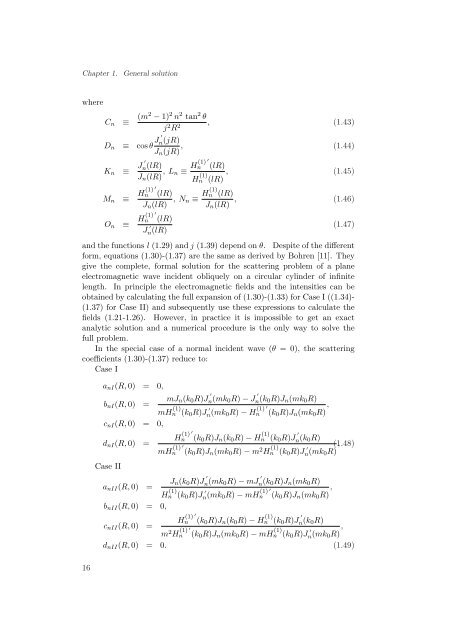Optical properties of cylindrical nanowires
Optical properties of cylindrical nanowires
Optical properties of cylindrical nanowires
You also want an ePaper? Increase the reach of your titles
YUMPU automatically turns print PDFs into web optimized ePapers that Google loves.
Chapter 1.General solutionwhereC n ≡ (m2 − 1) 2 n 2 tan 2 θj 2 R 2 , (1.43)D n ≡ cos θ J ′ n(jR)J n (jR) , (1.44)K n ≡ J n(lR)′ ′J n (lR) , L n ≡ H(1) n (lR)H n (1) (lR) , (1.45)′M n ≡ H(1) n (lR)J n (lR) , N n ≡ H(1) n (lR)J n (lR) , (1.46)′O n ≡ H(1) n (lR)J n(lR)′(1.47)and the functions l (1.29) and j (1.39) depend on θ. Despite <strong>of</strong> the differentform, equations (1.30)-(1.37) are the same as derived by Bohren [11]. Theygive the complete, formal solution for the scattering problem <strong>of</strong> a planeelectromagnetic wave incident obliquely on a circular cylinder <strong>of</strong> infinitelength. In principle the electromagnetic fields and the intensities can beobtained by calculating the full expansion <strong>of</strong> (1.30)-(1.33) for Case I ((1.34)-(1.37) for Case II) and subsequently use these expressions to calculate thefields (1.21-1.26). However, in practice it is impossible to get an exactanalytic solution and a numerical procedure is the only way to solve thefull problem.In the special case <strong>of</strong> a normal incident wave (θ = 0), the scatteringcoefficients (1.30)-(1.37) reduce to:Case I16a nI (R, 0) = 0,b nI (R, 0) =mJ n (k 0 R)J n(mk ′ 0 R) − J n(k ′ 0 R)J n (mk 0 R)mH n (1) (k 0 R)J n(mk ′ 0 R) − H (1) ′n (k 0 R)J n (mk 0 R) ,c nI (R, 0) = 0,d nI (R, 0) =Case IIH (1) ′n (k 0 R)J n (k 0 R) − H n (1) (k 0 R)J n(k ′ 0 R)mH (1) ′n (k 0 R)J n (mk 0 R) − m 2 H n (1) (k 0 R)J n(mk ′ 0 R) (1.48) ,a nII (R, 0) =J n (k 0 R)J n(mk ′ 0 R) − mJ n(k ′ 0 R)J n (mk 0 R)H n (1) (k 0 R)J n(mk ′ 0 R) − mH (1) ′n (k 0 R)J n (mk 0 R) ,b nII (R, 0) = 0,H (1) ′n (k 0 R)J n (k 0 R) − H n (1) (k 0 R)J ′c nII (R, 0) =n(k 0 R)m 2 H (1) ′n (k 0 R)J n (mk 0 R) − mH n (1) (k 0 R)J n(mk ′ 0 R) ,d nII (R, 0) = 0. (1.49)
















